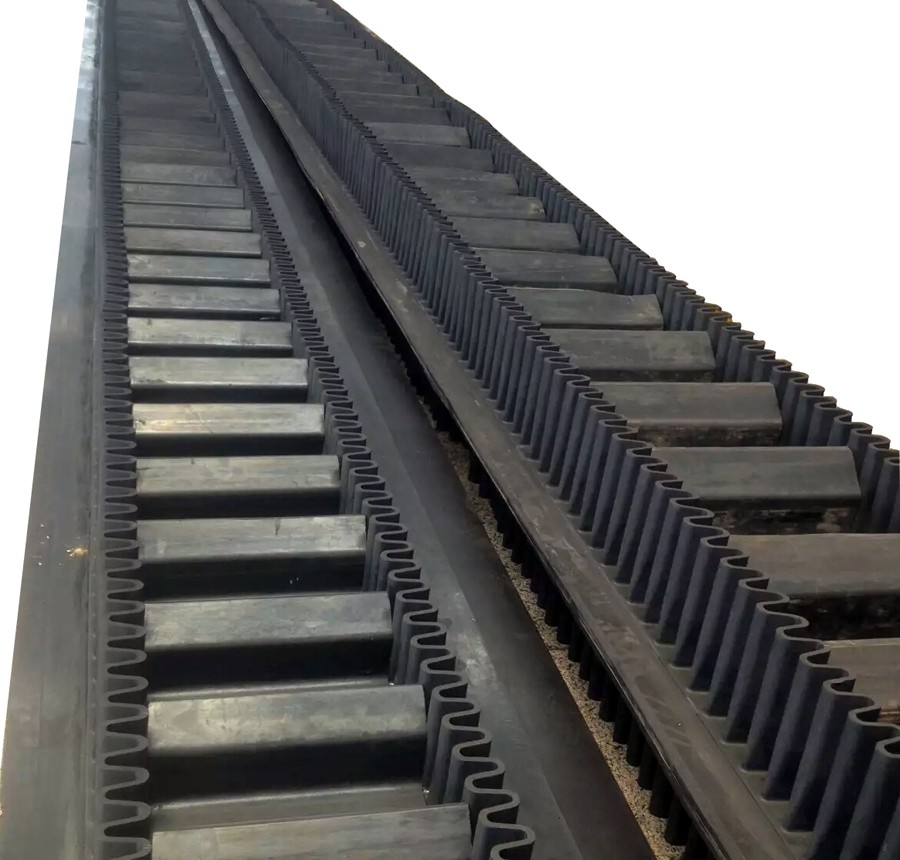Side wall belt for steel smelting operation

Our cleat is made of special rubber compound, with good features of impact resistant and hardness to avoid cleat distortion.Under high wearing condition,cleat blades can be fixed onto cleat base by screwing for convenient maintenance.
T cleat is normally used up to 40° conveyor angle C,TC and TCS are normally used form 40° to 90°. To avoid material leak from the gap between cleats and sidewalls, the cleats should be positioned to be the right sidewall corrugation for screwing reinforcement.
All Global RUBBER Cleats have been specifically designed to give optimum performance. The shape of the C and TC types have been created to offer best conveying capacities alone with excellent self-cleaning properties. The cleats are taken of the extruded type for the smaller profiles, all large cleats are moulded to give the best shape retention even when conveying high-density materials. Cleats profiles are shipped in non-returnable packing cartons, please refer to the below chart.
Specifications
| NN Carcass | EP Carcass | |
| Similarity | Lower longitudinal elongation; Higher tensile strength; Good flexibility and troughability; Good resistance to mildew, moisture and rotting; Excellent impact resistance; | |
| Difference | Woven by nylon both in warp and weft | Woven by polyester in warp and nylon in weft |
| Conveyor belt Market |
Aggregate,Baggage Handling,Bulk Handing, Cement,Coal, Foundry, Grain, Hard Rock, Package Handling,Wood Products, Sand and Gravel, Steel Products.
| |
| Conveyor Belt Tensile strength | 80~3000N/mm | |
| Width | 300mm-2500mm | |
| Conveyor Belt Features | 1,Reduced strength ; 2.High-modules, superior troughing characteristics; 3,Variety of cover compounds and cover gauges. | |
| Cover position intensity Mpa is not smaller than | 10 |
| The overburden layer abruption elongation ratio % is not smaller than | 350 |
Uses 100% to gather the nylon canvas to make the belt core general difficult to burn the belt, the level the bonding strength conforms to the following standard
| Target project | Cloth level | Overburden layer and cloth level | |
| Overburden layer thickness≤1.5mm | Overburden layer thickness>1.5mm | ||
| The complete test specimen mean value is not smaller than,N/mm | 5.0 | 3.5 | 3.9 |
| The complete test specimen lowest peak value is not smaller than,N/mm | 3.9 | 2.4 | 2.9 |
Uses the cotton fibre canvas to make the belt core general difficult to burn the belt, the level the bonding strength should conform to the following standard
| Target project | Cloth level | Overburden layer and cloth level | |
| Overburden layer thickness≤1.5mm | Overburden layer thickness>1.5mm | ||
| The longitudinal model mean value is not smaller than,N/mm | 2.7 | 2.4 | 2.7 |
| The longitudinal model lowest peak value is not smaller than,N/mm | 2.0 | 1.6 | 2.0 |
Uses other textile fiber canvas to make the belt core general difficult to burn the belt, the level the bonding strength should conform to the subscript
| Target project | Cloth level | Overburden layer and cloth level | |
| Overburden layer thickness≤1.5mm | Overburden layer thickness>1.5mm | ||
| The complete test specimen mean value is not smaller than,N/mm | 3.5 | 2.4 | 3.0 |
| The complete test specimen lowest peak value is not smaller than,N/mm | 2.7 | 1.6 | 2.2 |
Overburden layer physical property
| Flame retardancy energyJ | Difficult to burn and to lead the static electricity performancek |
| Three longitudinal entire thickness test specimen’s flame duration’s mean value is not bigger than | The flame retardancy can lead the static electricity performance surface request with J not to be bigger than 3×108Ω |
| and 60S any single result does not have the afterburning phenomenon |
tetur adipiscing elit. Ut elit tellus, luctus nec ullamcorper mattis, pulvinar dapibus leo.
| Type | Rubber Cover Type | Tensile strength at break(N/mm2) | Elongation at break % | Abrasion mm3 |
| Abrasion Resistant | RCB-AR-M | 24 | 450 | 120 |
| RCB-AR-Y | 20 | 400 | 150 | |
| RCB-AR-W | 18 | 400 | 90 | |
| RCB-AR-N18 | 18 | 450 | 200 | |
| RCB-AR-N | 17 | 400 | 200 | |
| RCB-AR-A | 17 | 400 | 70 | |
| RCB-AR-Z | 15 | 400 | 250 | |
| RCB-AR-II | 14 | 350 | 280 | |
| RCB-AR-L | 10 | 350 | 300 | |
| Oil Resistant | RCB-FOR | 12 | 300 | 300 |
| RCB-MOR | 15 | 450 | 250 | |
| RCB-LOR | 17 | 450 | 200 | |
| Heat Resistant | RCB-HR-T1-100oC | 17 | 400 | 250 |
| RCB-HR-T2-125oC | 15 | 350 | 250 | |
| RCB-HR-T3-150oC | 13 | 350 | 250 | |
| RCB-HR-T4-180oC | 11 | 350 | 280 | |
| RCB-HR-T5-300oC | 10 | 350 | 300 | |
| FR/AR/AS Resistant | RCB-ARAS | 18 | 450 | 200 |
| RCB-FRAS | 14 | 400 | 250 | |
| RCB-FR | 12 | 350 | 300 | |
| Cold Resistant | RCB-CR-T1– -30oC | 17 | 350 | 300 |
| RCB-CR-T2– -50oC | 14 | 300 | 300 | |
| Chemicl Resistant | RCB-ANTI-ACID | 14 | 400 | 250 |
| RCB-ANTI-ALKALI | 14 | 400 | 250 |
